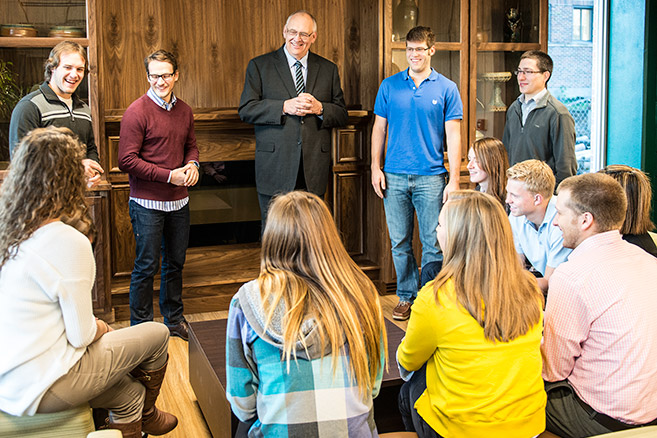
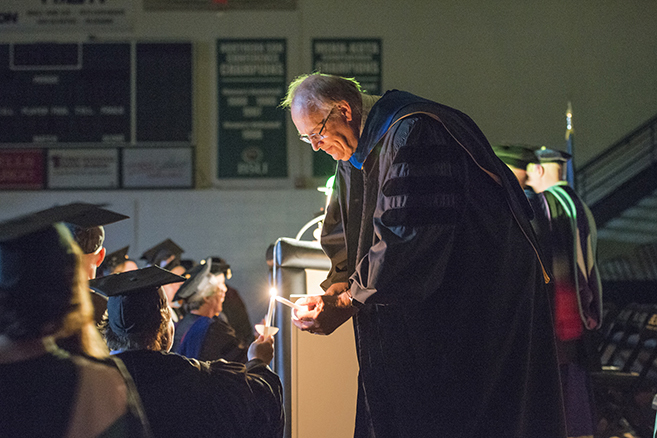
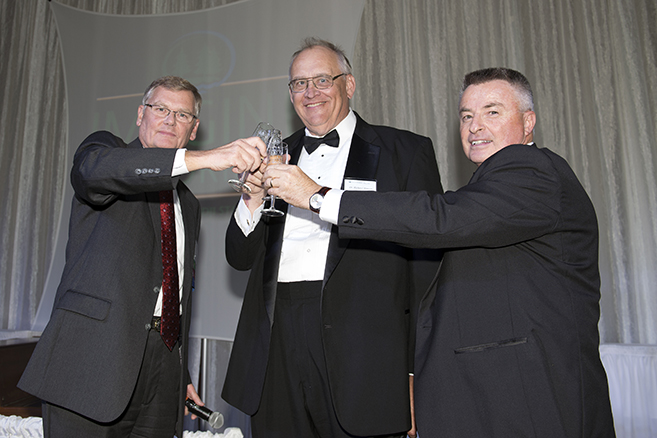
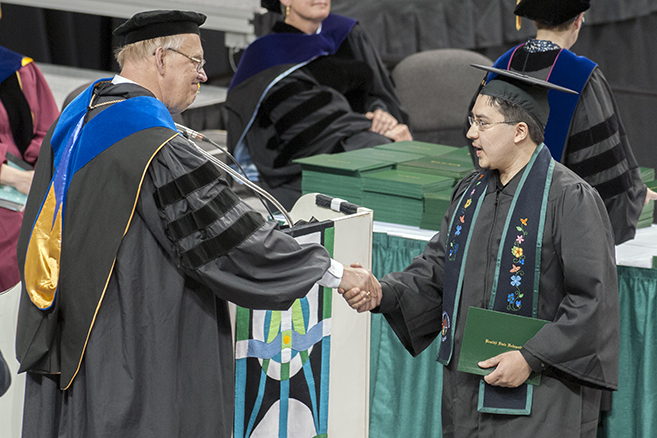
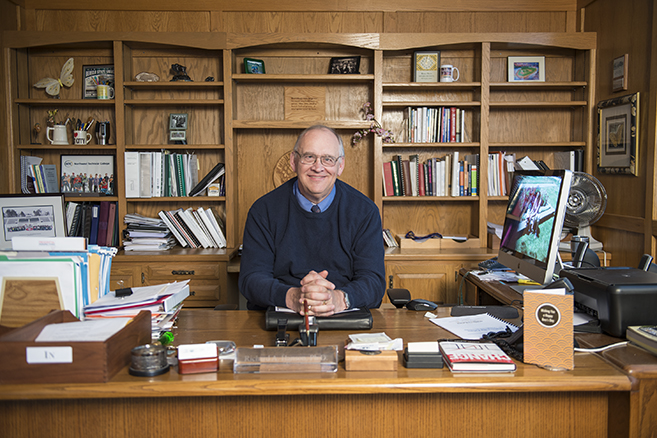
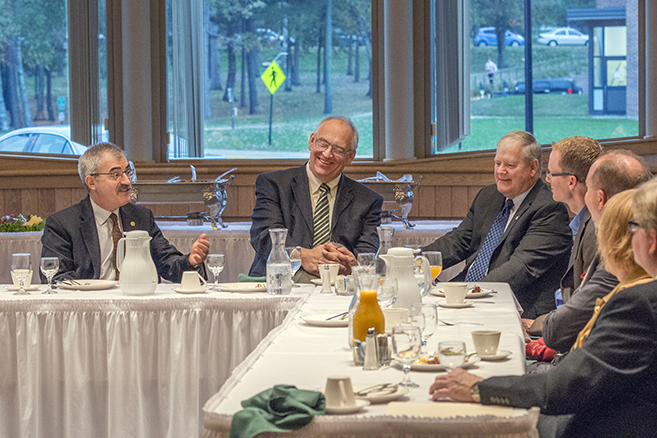
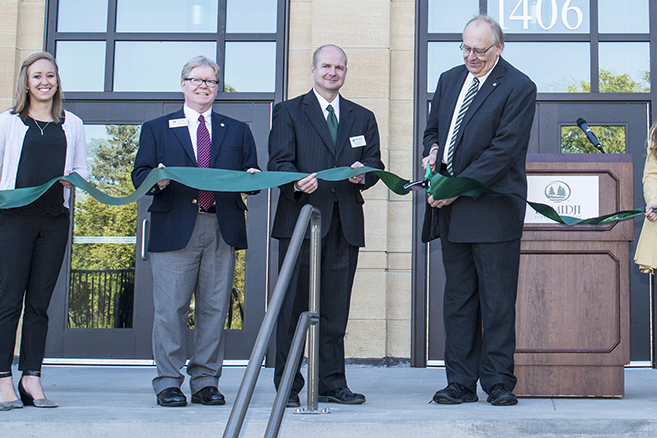
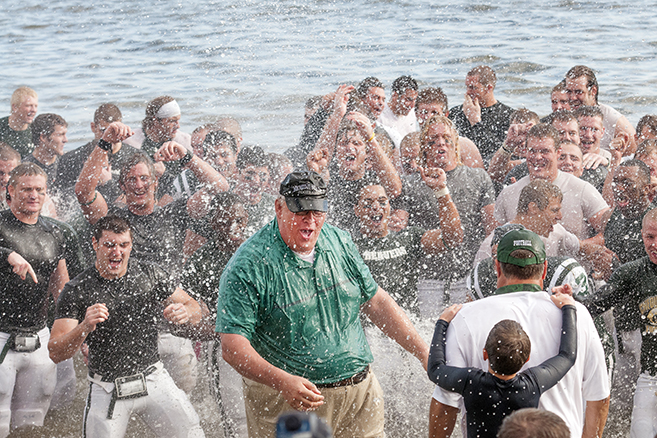
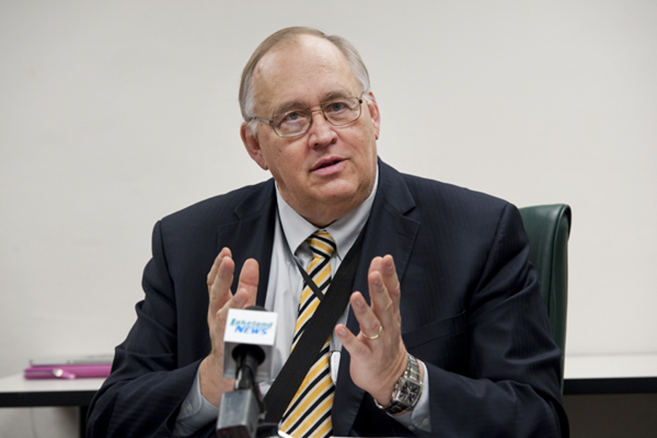
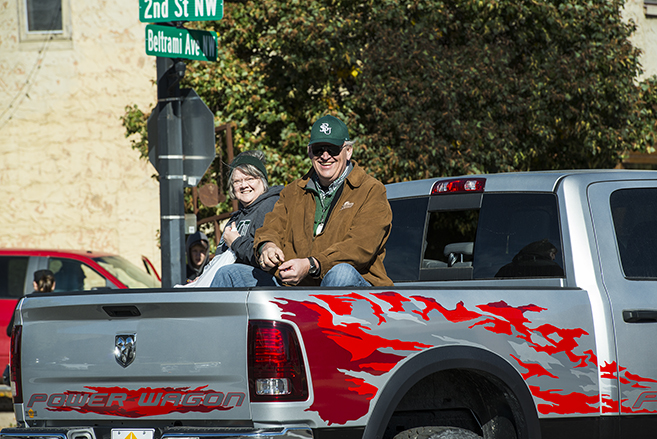
Demolition and construction have redrawn the Bemidji State University map during Dr. Richard Hanson’s six years as president. BSU’s identity has evolved as well.
At ground level, Sanford and Maple halls are gone. Birch and Decker halls are renovated. New stadium turf is installed. Memorial Hall is transformed. If state bond funding comes through, Hagg-Sauer Hall will be replaced in 2018 with a smaller classroom building in the same location.
| Dr. Richard A. Hanson |
|---|
|
– ADMINISTRATION – 2010-16 — President, Bemidji State University and Northwest Technical College. 2009-10 — Interim president, North Dakota State University, Fargo. 2005-09 — President, Waldorf College, Forest City, Iowa. 1995-2005 — Vice president for academic affairs and dean of the college, Augustana College, Sioux Falls, S.D. 1982-95 — Interim vice president for academic affairs (1995) and interim dean of the College of University Studies (1994-95). Associate vice president for academic affairs (1992-95), associate director of human development and extension service (1991-92), department chair, child development and family science, (1983-87), director, Family Studies Institute (1984-87), North Dakota State University. 1979-80 — Department chair, home economics, California State University, Chico, Chico, Calif. – TEACHING – 2006-10 —Waldorf College 1997-2005 — North Dakota State University 1974-80 — California State University, Chico – EDUCATION – • Doctorate in applied behavioral science, University of California, Davis, 1980. • Master of science in child development and family relations, North Dakota State University, 1974. • Bachelor of science in sociology, with a second major in child development and family relations, North Dakota State University, 1971. – SCHOLARSHIP – Authored more than 25 competitive grant awards, 19 refereed journal articles, 12 other publications, five books and monographs and more than 30 professional conference/association presentations.
Dr. Hanson and his wife, Dianne, have three daughters and three grandchildren. They |
Beneath the surface, Bemidji State’s first comprehensive fundraising campaign has fostered a culture of philanthropy, as Hanson hoped it would. Since he undertook what he called a strategic “recalibration” of institutional priorities in January 2011, which shrunk or eliminated two dozen academic departments, several other majors have been created or expanded.
And along the closely watched continuum between the liberal arts and professional programs, he acknowledges BSU has edged slightly toward the professions during his tenure.
“Change,” Hanson is known to say, “is the only constant in higher education.” He has experienced a lot of it and foresees as much or more for his successor, Dr. Faith Hensrud, who is leaving the University of Wisconsin-Superior to become BSU’s 11th president on July 1.
Hanson’s view of change as both inevitable and accelerating explains why he has approached retirement more as a baton exchange between sprinters than some sort of personal or institutional finish line.
“Just like our culture, presidencies now are kind of in and out,” he said. “You’ve got to run like mad for a relatively short period of time and try to do the best you can. More than ever, the game is in the transition.”
Not one to dwell on roads not taken, Hanson has looked determinedly ahead throughout the 42-year educational career he began after a two-season foray into pro football with the New York Giants.
Because he’s not inclined to putter over hobbies or home repair, Hanson soon will have a wealth of time to dote on his grandchildren. He also can devote more hours to studying his beloved Kierkegaard while exploring ways to share what he’s learned as a college and university president, vice president, dean, director, department chair and faculty member in child development and family science.
Hanson will depart northern Minnesota, joking like a proud North Dakotan that the north woods have “too many trees.” He and his wife, Dianne, will settle in Sioux Falls, S.D, close to their three daughters and in surroundings familiar from his decade at Augustana College.
Though he says it will be hard to give up the lofty endeavor, seasonal routine and collegiality of higher ed, Hanson is certain it’s time to step away.
“I think we’ve moved the university forward in terms of facilities; I think we’ve moved the university forward in terms of planning; and I like to think we’ve moved the university forward in terms of grappling with our future as a comprehensive, residential liberal arts college in a rural area with Division I and Division II sports,” he said.
Now and in the decades to come, the most indelible imprint of Hanson’s presidency at Bemidji State University will be on the BSU campus itself.
The first of several notable improvements completed on his watch was a $6 million facelift of Birch Hall, a residence hall across Birchmont Drive from Chet Anderson Stadium. Completed in summer 2012, the work included co-ed bathrooms on each floor and new lounges that connect wings on the second and third floor.
On the lake side of Birchmont, new artificial turf was installed at the stadium in the summer of 2013. The $1.3 million project, which included removal of a deteriorated track, was funded in part through a partnership with the Bemidji school district. The Bemidji High School and BSU football and soccer teams compete there, and it’s increasingly used for post-season play.
“Before the turf, we did about 11 events on the field a year — BSU and community,” Hanson said. “So it wasn’t used all that much. And last year, we did 40, so it’s worked beautifully.”
The most significant campus project he has presided over is the complete interior renovation of the 75-year-old Memorial Hall gymnasium as a new home for the College of Business and its business administration and accountancy programs.
Funded with $16 million in state bonding money, the work included demolition of adjacent Sanford Hall, which opened in 1920 as a residence hall but was used for student services in recent years; demolition of Maple Hall, a residence hall that opened in 1967 but was no longer needed; and renovation of Decker Hall as a new hub for student services.
Though Sanford was demolished in 2014, a University of Minnesota professor for whom it was named, Maria Sanford, will be remembered with a plaque on the Sanford Quad. This expanse of lawn and sidewalks stretches in front of the Upper Hobson Memorial Union, from A.C. Clark Library on the south to Memorial Hall on the north.
That new open space, facing Birchmont Avenue across from the David Park House, has been an under-recognized dividend of the Memorial Hall project, Hanson said. When Sanford Hall was wedged into that area, he said, “It felt like we didn’t have a front door.”
The $18.1 replacement of Hagg-Sauer Hall near the lakeshore will be another massive undertaking if the Legislature OKs bond funding this spring. Demolition of the 46-year-old 82,000-square-foot building, scheduled for next summer, will wipe out $8 million in deferred maintenance, much of it from basement water seepage.
Downsized to 25,000 square feet to improve overall campus space usage, the planned new Hagg-Sauer Academic Learning Center has an energy-efficient design and a variety of versatile, interactive learning spaces.
Included in the cost is renovation of A.C. Clark Library, Bangsberg Performing Arts Complex, Bensen Hall, Deputy Hall and Sattgast Hall to make room for 110 faculty offices now in Hagg-Sauer and overall redistribution of university faculty into learning communities that encourage their own collaboration and more interaction with students.
Although these campus improvements have not been free of pushback or delay, nothing has matched the challenge that greeted Hanson on day one of his presidency — a two-year, $5 million budget deficit. Six months into his new job, he acted decisively by cutting 50 faculty positions and 10 administrative and staff jobs and eliminating men’s track and field.
BSU’s revered but severely under-enrolled theater department was cut, and the visual arts department was folded into a new department with technology and design. Those moves drew loud protest within the Bemidji-area arts community.
Among programs retained but reduced because of relatively low enrollment were music, philosophy, history, mathematics, physics and economics.
Hanson emphasized in messages to the campus and community that these steps were vital to BSU’s long-term financial and academic sustainability, not simply a Band-Aid to staunch red ink from rapidly shrinking state support.
And they weren’t all cuts. He added faculty positions to business administration, mass communication, Native American studies (now called indigenous native nations) and Ojibwe language. His charge for an academic initiative in leadership and
ethics bore fruit last year with a new minor and certificate program in leadership. Hanson also put greater focus on environmental sustainability and underscored the need to recruit and retain more underserved students, especially American Indians from the three tribal nations surrounding Bemidji.
In the years since the budget recalibration, BSU has added an undergraduate major in wildlife biology; new emphasis areas in art and design, criminal justice and environmental studies; and online master’s degrees in business administration and teaching. Among other initiatives, it has launched off-campus bachelor’s degree-completion programs in biology at North Hennepin Community College and business administration at Anoka-Ramsey Community College and expanded its baccalaureate nursing program to four two-year colleges.
Despite the angst over recalibration, the fine arts have remained a vibrant part of BSU’s academic and student life. The Department of Music has begun staging an opera every other year, and the visual arts program is strong, even though it no longer stands alone. At Hanson’s request, the BSU Foundation board allocated $500,000 to ongoing lease expenses for a BSU gallery within the new Watermark Art Center in downtown Bemidji and $160,000 to support travel by BSU student choir and instrumental groups.
A parallel chapter in Hanson’s presidency began in July 2011. Six months after the uproar over program cuts and reductions, he and the BSU Foundation Board launched the quiet phase of the five-year Imagine Tomorrow fundraising campaign.
The campaign will coincidentally conclude on Hanson’s last day as president. Many considered its $35 million goal overly optimistic, but the effort already has exceeded its goal by a million dollars, more than doubling the university’s endowment and scholarships awarded.
Hanson said he’s been moved by the generosity of alums and other donors who’ve stepped up with gifts and pledges of all sizes, including several totaling millions of dollars.
“We have a collection of alums and supporters that I’ve gotten to know through the campaign who are brilliant in the sense that they have a vision for the future,” Hanson said. “I will tell the new president, ‘You have some people here who care deeply about sustaining BSU as a relevant institution — not necessarily as it was when they graduated.’”
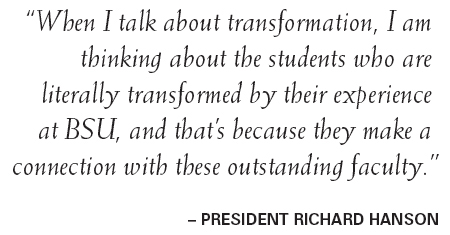 Likewise, he credits the difference that faculty members have made in the lives of students, an impact that often leads directly to alumni giving decades later.
Likewise, he credits the difference that faculty members have made in the lives of students, an impact that often leads directly to alumni giving decades later.
“We have some fabulous individuals who do amazing work with kids,” Hanson said. “When I talk about transformation, I am thinking about the students who are literally transformed by their experience at BSU, and that’s because they make a connection with these outstanding faculty.”
He said it is those students — the challenges they overcome and the way they blossom — that makes the university a distinctive place that he will miss dearly, trees or no trees.
Looking at BSU from the perspective of a parent, Hanson noted the relative lack of high-end or even late-model cars in student parking lots. He said the university is decidedly non-elitist in socioeconomic terms, despite providing students with top-notch facilities and excellent academic programs.
“If you sort through everything that comes at you, what kind of environment do you really want your child to be immersed in?” he said. “We’re special because of this unique place and the fact that we will ground you in both the liberal arts and the professions.
“We offer a very practical but very, very enlightened kind of education, and I wouldn’t have it any other way.”
Written by Scott Faust
